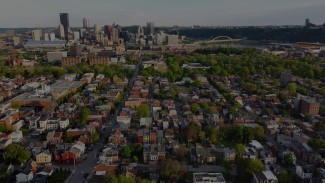Key findings
|
Today’s extreme weather events often result in prolonged power outages, economic losses, and risks to public safety, highlighting the urgent need to improve the resilience of our buildings and grid system. Utility energy efficiency retrofit programs, such as building weatherization and equipment replacement programs, are a cost-effective, low-emissions approach to help buildings maintain safe and comfortable conditions during power outages and reduce overall stress on the grid. This report examines how utilities evaluating these strategies for program planning and screening decisions can estimate improvements in a neighborhood’s collective resilience when multiple buildings have efficiency upgrades.
Valuing resilience at the neighborhood level can inform how investments are prioritized
Utilities and policymakers often struggle to fully quantify the value of building efficiency upgrades for local neighborhoods to understand the aggregated impacts on total savings, costs, and continued reliability and customer safety. Existing methodologies focus on evaluating the benefits of building upgrade investments on the level of either a single building or the utility grid system. This limits the adaptability of the approaches to (1) aggregate resilience benefits from a group of building upgrades at the neighborhood or community level and (2) understand how those upgrades impact overall resilience and grid stability.
Given the deficiencies and complexity of traditional methods, a simplified approach that quantifies key resilience benefits across a group of buildings and the grid can inform a more structured framework for program screening and investment. By focusing on key metrics such as lower peak demand, shorter outage time, and lower interruption costs, utilities and policymakers can simplify the integration of resilience benefits into cost-benefit analyses and better prioritize investments. Furthermore, a simplified approach can help bridge the gap between individual building-level performance and overall grid resilience.
Four steps can help integrate resilience benefits in decision-making
For decision-makers to prioritize retrofit measures that offer resilience benefits, they must understand the risks of weather and climate events (using the latest climate data to model their impact) and identify the geographical location with a mix of residential and commercial buildings that are most vulnerable. They can then analyze energy efficiency retrofits that address resilience gaps, accounting for both current usage and the impact of efficiency measures, and ways to calculate and communicate the resilience benefits from investments. We explain these considerations in detail in this report and recommend steps that utilities and policymakers can take to estimate the value of resilience from energy efficiency investments.
Our analyses of resilience benefits for a study area in Westchester County, New York, finds that coordinating retrofit solutions—such as pairing building envelope measures with heat pumps upgrades and implementing them at the neighborhood scale—avoids exacerbating grid vulnerabilities and helps maintain reliable power. Retrofit measures play a crucial role in enhancing overall building and system resilience by reducing demand during peak periods (up to 8% on a peak summer demand day); shortening outage duration (63% lower in the peak summer month of September); and reducing costs associated with interruptions.
Actions to improve resilience valuation
While improving grid reliability and resilience has received policy attention in recent years—such as through winterization regulations and performance credit mechanisms—demand-side measures such as energy upgrades that improve building resilience and reduce strain on the grid during extreme weather events have not featured as prominently in regulatory decisions. By considering actual climate data and neighborhood energy consumption patterns, utilities and policymakers can make more informed decisions about where to invest in energy efficiency and electrification to improve grid stability and community resilience during extreme events. The following actions can further advance the integration of resilience impacts into cost-benefit analyses and encourage greater adoption of demand-side solutions.
Actions for regulators
- Accelerate the adoption of resilience valuation methodologies, including guidance for how utilities assess and incorporate the value of resilience into their investment decisions to inform program screening and selection processes.
- Standardize metrics for resilience—such as for reduced peak demand, reduced outage duration, and lower interruption costs—so that utilities can more accurately assess and compare the impact of different energy efficiency measures on building and grid resilience.
- Develop approaches for identifying the beneficiaries of resilience investments, especially in vulnerable communities, and allocate the cost among customer groups.
Actions for utilities and program administrators
- Move beyond the individual building-customer level to a neighborhood-scale perspective on the resilience benefits from building energy efficiency measures to help reduce collective disruptions and ensure more stable energy systems during extreme events; this benefits both individual buildings and the grid.
- Conduct detailed analyses of energy efficiency measures at the neighborhood scale using program participant data to help utilities compare costs and their impact on enhancing the value of resilience for better program design, planning, and evaluation. These analyses can help promote and scale energy retrofits by highlighting their energy and resilience benefits.
Actions for federal and state policymakers
- Advocate for policies and incentives that subsidize energy efficiency upgrades, such as building envelope upgrades, to reduce barriers to adoption for building owners.
- Assess the cost of electrification for customers and provide financial incentives to reduce the higher upfront costs of electrification measures, which have the potential to reduce peak loads, minimize outage durations, and decrease interruption costs, thereby enhancing neighborhood resilience.
Download the report
| Suggested Citation |
Srivastava, Rohini, Emily Garfunkel, and Lyla Fadali. 2025. Beyond the Building: Strengthening Neighborhood Resilience Through Energy Efficiency Programs. Washington, DC: ACEEE. www.aceee.org/research-report/b2505. |



